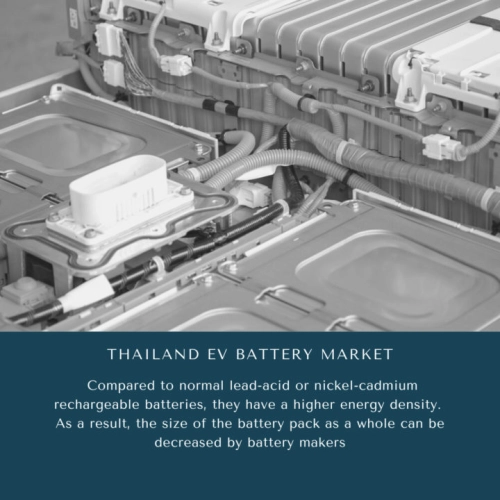
- Get in Touch with Us

Last Updated: Apr 25, 2025 | Study Period: 2023-2030
Several portable gadgets and electric vehicles use lithium-ion (Li-ion) batteries, a kind of rechargeable battery. Compared to normal lead-acid or nickel-cadmium rechargeable batteries, they have a higher energy density.

As a result, the size of the battery pack as a whole can be decreased by battery makers. Governments all are promoting the adoption of cars utilising alternative fuels as a result of the growing concerns expressed about the environmental effect of conventional automobiles.
EVs are zero-emission cars that are becoming more and more popular for eco-friendly public transportation. To promote the use of EVs, some national governments provide financial incentives such as tax exemptions and refunds, subsidies, decreased parking/toll rates for EVs, and free charging.
The Thailand EV Battery Market accounted for $XX Billion in 2022 and is anticipated to reach $XX Billion by 2030, registering a CAGR of XX% from 2023 to 2030.
The research and manufacturing of zinc-ion batteries to power electric cars (EVs) would be funded by the Thai government, according to local publications quoting a major executive involved in the project.
Thailand wants to create a domestic market for electric vehicle batteries that will utilise the abundant zinc that exists there.
The government has decided to provide the NSTDA THB192 million to assist in funding the development of a pilot plant with a production capacity of one megawatt-hour of zinc-ion batteries for EVs. Zinc, manganese oxide, and graphene will be the batteries' primary raw components.
The oil and gas conglomerate PTT of Thailand has formed a new joint venture with its power generation subsidiary Global Power Synergy (GPSC) to assess the feasibility of constructing a new electric vehicle (EV) battery plant in the nation.
Nuovo Plus will look into investment opportunities in the EV battery supply chain prior to PTT's plans to manufacture zero-emission commercial vehicles in the nation.
Along with developing an EV charging network and creating a digital platform for EV drivers, it plans to construct a new battery production facility in Rayong, on Thailand's eastern shore.
Additionally, GPSC intends to increase the yearly battery manufacturing capacity at its present plant in the nation from the current 30 megawatts to 1 gigawatt-hour (GWh) of semi-solid batteries.
| Sl no | Topic |
| 1 | Market Segmentation |
| 2 | Scope of the report |
| 3 | Abbreviations |
| 4 | Research Methodology |
| 5 | Executive Summary |
| 6 | Introduction |
| 7 | Insights from Industry stakeholders |
| 8 | Cost breakdown of Product by sub-components and average profit margin |
| 9 | Disruptive innovation in the Industry |
| 10 | Technology trends in the Industry |
| 11 | Consumer trends in the industry |
| 12 | Recent Production Milestones |
| 13 | Component Manufacturing in US, EU and China |
| 14 | COVID-19 impact on overall market |
| 15 | COVID-19 impact on Production of components |
| 16 | COVID-19 impact on Point of sale |
| 17 | Market Segmentation, Dynamics and Forecast by Geography, 2023-2030 |
| 18 | Market Segmentation, Dynamics and Forecast by Product Type, 2023-2030 |
| 19 | Market Segmentation, Dynamics and Forecast by Application, 2023-2030 |
| 20 | Market Segmentation, Dynamics and Forecast by End use, 2023-2030 |
| 21 | Product installation rate by OEM, 2023 |
| 22 | Incline/Decline in Average B-2-B selling price in past 5 years |
| 23 | Competition from substitute products |
| 24 | Gross margin and average profitability of suppliers |
| 25 | New product development in past 12 months |
| 26 | M&A in past 12 months |
| 27 | Growth strategy of leading players |
| 28 | Market share of vendors, 2023 |
| 29 | Company Profiles |
| 30 | Unmet needs and opportunity for new suppliers |
| 31 | Conclusion |
| 32 | Appendix |